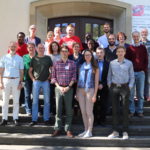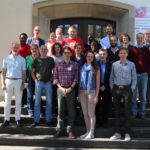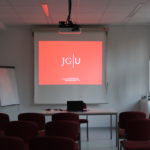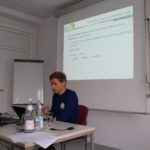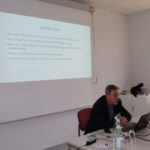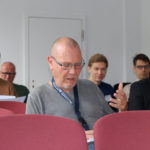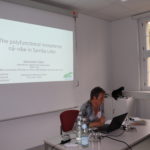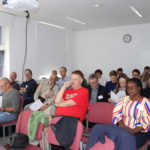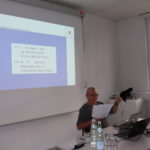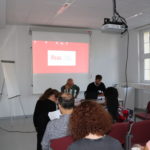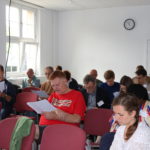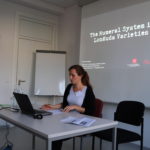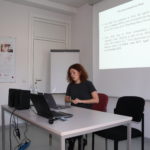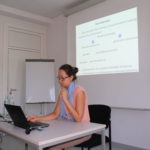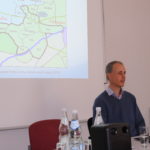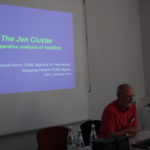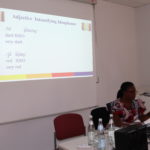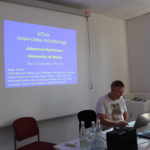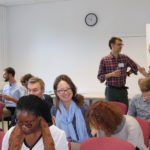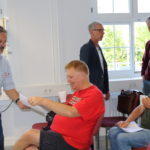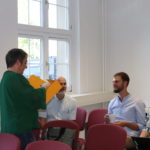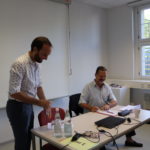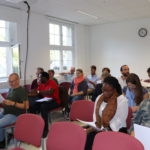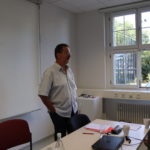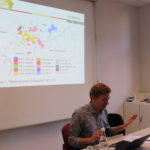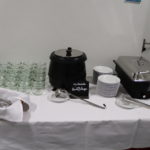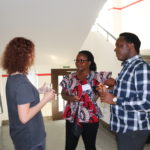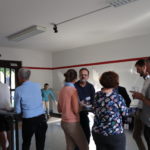Field notes by Ulrich Kleinewillinghöfer 1985, 1991/1992, 1995
Nii Yebu wordlists YEBU-LEX - WEB
- Introduction
The people known as "Awak" are one of mionority groups in the southern part of Gombe State, Nigeria. Awak, (aka Awok), is the name given to them by some of their neighbours. They are also known as Awaa to the Waja, as Yia to the Kamo (aka Maa) and as Mwaarɛ to the Tula of Wange. Their own appellation is Yebu [yébú] to refer to the people and Nii Yebu to refer to their language.
Both, Awak and Awok are nevertheless, commonly used in the early reports, files, and wordlists of the colonial administration, written by Carlyle, Hall, Walker, Meek, Mathews, presumably following the way how the Tangale also call them. Accordingly, we find "Awak" in overviews based on the early data, e.g., in Temple 1922, Hansford et al. 1963, Greenberg 1963 and so on.
Nii Yebu (~ Awak) is a member of the Tula-Waja language groups which is one of the distinct linguistic units within a continuum of languages which spans from the Volta Basin to the Upper Benue Basin with diaspora groups on the upper Shari in Chad. Morphologically its closest relatives are the language groups classified under Central Gur, while Greenberg 1963 and others classified Tula-Waja as a member of the so-called Adamawa Branch of Adamawa-Ubangi. Cf. Kleinewillinghöfer 2020, Güldemann 2018.
The first wordlists are presumably those collected by Reverend John Hall of the S.I.M. at Kaltungo on request of the colonial anthropologist C.K. Meek. The lists are contained in various files in the National Archives in Kaduna. I copied them and attached them in the Appendix below..
A wordlist accompanied by some grammatical information was collected by Jungraithmayr 1962/63 in Kaltungo. His notations are a bit flawed by the disregard of the 10 vowel ATR-harmony system which prevails in Nii Yebu. However, knowledge of ATR vowel harmony systems and its distinguishing feature became only commonly known several years later.
2. Some notes on the Yebu people
The available population figures:
Mathews 1934: 1.834
census of 1963: 5.021
census of 1991: 22.179
show a rapid increase of the population. Yet, the latter figure counted the population of the entire Awak Village Area, and thus all the settlements under the Chief of Awak. Since there has been a steady influx of foreign settlers from the North, who also founded new settlements within Awak Area, a large portion of the population figure in the 1991 census were most likely not Awak speakers.
At the time of their subjugation under the colonial rule in the first decade of the 20th century (see an account of a battle with colonial troops in Adelberger (2009) they occupied five hamlets on 'Awak Hill'. The majority of the Yebu were farmers who cultivated on the hill and on the slopes in terraced farms and had additional farms, outfields, in the plains around. After World War II, they created permanent new settlements in the foothills and plains around, mostly to the north of Awak Hill. Thus, their mountain fastnesses became gradually deserted. Jungraithmayr 1961 was told by his assistant, that the majority of the people settled already in the plains, though "some of their villages, however, are still on the hills“ (1968/1969: 198). In 1991 when we[1] were led to the old settlements on Awak Hills, the villages were almost deserted though former gathering and ritual places as well as the shrines were still used and maintained.
While the hamlets on Awak Hill were rather close to each other, at a maximal distance of about 2 km , the distance between the various settlements increased significantly when the Yebu moved down to the adjacent plains. The distance between Kunge and Yelwa is now more than 8 km as the crow flies.
People from the northern hamlets settled to the north, most prominently to Yelwa (= Sabon Gari Awak), the seat of the Chief of Awak. Those from the southern part of Awak Hill founded their new settlements to the south, e.g. Sholeŋi and Kunge. Possibly, the people when leaving their old settlements build their houses in/near their outfields.
During colonial times in the frame of the 'Indirect Rule' scheme, the Awak were officially represented by only one acknowledged headman. He was referred to as ''Village Head of Awak", and was under the "Sarkin Kaltungo", the "District Head". Within the Awak area, the Village Head Awak had the say, when dealing with customary issues. The various Awak settlements were each presided by a "mai anguwa", who, together with the clan heads, took care of the administrative aspects within their settlement.
I was told, the first chief of Awak, fáŋ kwi (?? Shobol) was from Kwiyáŋ; later the chieftaincy went to Keebu people.
Yebu clans:
I took a few notes as to which clans were prominent in the five main settlements on Awak Hill. This is not the result of a systematic and comprehensive study and may have gaps or faults.
Soboloŋ, shoboloŋ [sholeŋí] (feilangə ??)
- Diyakú diyakúú; Karankúl, Yillú ( ténti - yìlu), Cindakú (Shindakúú)
Yerí (Yerbo) (taayo ??)
- Talə́boom, Duŋkadii
Kunge [Kwiyeŋí] (madi ??)
- Fɔɔri; Bʌteni, Bakiye, Boom̀, Weshaŋbo
Tondolí (tanga ?? ) tondulí
- Neɓakwár, Tint Wərá, Nəbakʌ́llì
Keebu (Yelwa) keebù
Kwalashine : Famwɛbɔ, Tɛɛshirbo, Bilatiyabó
Bilatiyá :(Gangafi ??),: Dəterbú, Bidefedú, Bidefidú, Daurí
Of interest are also the Kakalbó who once occupied Baŋ Yebu but have scattered since. They may have originated from Tangale. If they were the people responsible for the significant amount of Tangale lexemes in the Nii Yebu, is not known.
The proximity of the Awak Hill to the Tangale section of Ture was probable the reason for the reported hostile/war-like relation in the late 19th century and which hadn't stopped when British colonial forces arrived to subjugate the people in this area (1906). A NAK file reports a famine in Ture caused by the killing of Ture people in their farms by Awak warriors. The Ture people thus feared to go to their farms.
The colonial administration send a patrol to punish and subjugate the Awak. Yet, the Awak did not surrender straight away but prepared to fight the patrol. In the subsequent skirmish/battle more than 40 Awak were killed before they finally surrendered. Adelberger 2009 cites from the NAK file where this battle is described in detail.
From the intelligence reports written by various colonial officers (Carlyle, Walker. Mathews) we can deduce the Awak are composed of an autochthonous people, which was joined by migrants, among them above all a significant portion of Tera (see below). However, judging by the loans in the lexicon, the assumed influx of Tera speakers has left much less traces in the lexicon than what resulted from their contacts with the neighbouring speakers of Bole-Tangale languages, in particular Tangale.
Mathews 1934 (N.A.K: Bau Prof 231F Pagan Administration Tangale-Waja District.:
"AWAK (YIBU) §58 They are supposed to be the first inhabitants of what is now East Tangale District. Long ago, a man Anunu and a woman Kelifide emerged from a hole at the foot of Awak hill, having travelled underground from the east, and went up on the hill and built themselves a house. Kelifide had long hair which hung down to her waist. She was pregnant when she came out of the earth, and soon gave birth to a daughter, Balu, followed at intervals by two sons, Langwam and Kelewaja, and lastly another daughter, Yille. When they grew up, they had to marry one another as there was no one else for them. So Langwam married Balu, and Kelewaja married Yille. From them sprang the "Tondon" element of Awak.
§ 59. One morning Anunu found a large number of people camped at the foot of the hill. He gave them fire at their request, and they told him that they had come from Deba Habe under Ashono, and that they were of Tera stock. They had Tera marks and spoke the Tera language, but they settled down at Awak and intermarried with the Tondon people and adopted their tribal marks and language. Ashono became chief (fengwe) of Awak and his chief counsellor was the head of Tondon. Their descendants occupy corresponding positions to-day. There is also a priest (Fankomba) who is the deputy of the Fengwe, in whom the religious cults (except for the earth and harvest-cults, which are in the hands of the head of Tondon) are vested. He is the nominee of the Fengwe and is as a rule a son or younger brother. The present Fankomba is the son of the Fengwe's younger brother. He is called Kere and his uncle, the chief and village head, …, is called Kughu. ..
§ 60. Awak was not conquered by the Jukons of Pindiga or Panda, nor by the Fulani, though the latter attacked them. " … They had friendly relations with West Tangale, Kamu, Tula Wange, Panda and Waja and intermarried with all of them and with the Tera.
(This is their story, but it may be that in practice they are thinking of post-Administration days, for it would have been difficult to affect intermarriage with most of these tribes in the normal disturbed state of the country before that."
faŋ tɩmɛ́ owner of the land of Awak (from tandál area of tintərá)
Yebu settlements (noted in various interviews )
Land of Awak = tɩmɛ́n yébú
kuŋɛ = kwiyʌŋí; sɔ́blɔ́ŋ = sholeŋí; yɛrɩ = yerbò; tàngà - tondól [farsan] ; kʌ́n dʌ̀ŋì
yelwá - sabon layi awak ; wiyákà ?
anguwan baabù; gangarɩ́; bilatiyá; kwalá shine; kwabelaakɛ; fùùn
fɛɛka - mandɩ́; kuren; ɓwaarà; kawʋ́r;
dogon ruwa (wʋ́cɛ); garin bako
dundaye; garín baráʋ́; latashinɛ; saleyawa ; shale fwara (near fɛɛka)
lugádi
bagum kɔrau; gida goma (near fɛɛka); tintərá; keebu;
kakalbó (old settlement on baŋ yébú)
kʌntʌ́ŋ, kantáŋ place where water was fetched.
Mountains:
baŋ ténshɛ́bɔ́ ~ ténjɛ́bɔ́; baŋ ringami; baŋ kakalí; baŋ yébú; baŋ miyabo; tɩyan yerbo
References
Unpublished Files in the National Archives, Kaduna (NAK)
Carlyle, T.F. (1913). "Central Province, Gombe Emirate, Ako District, Waja Sub-District, Assessment Report". File: SNP 10 – 715p (1913); NAK.
Carlyle, T.F. (1914). "Central Province – Gombe Emirate – History. The Districts of Gombe Emirate." File: SNP 10 - 445p; NAK.
Mathews, A.B. 1934. "Report on the Tangale-Waja Districts". File: Bau Prof 231F Pagan Administration Tangale-Waja District. National Archives Kaduna.
Walker, S.W. (1929). "Waja District, Gombe Division, Bauchi Province. Assessment Report". File: SNP 17 - 9033 (1929); NAK.
Adelberger, Jörg. 2009. Maxims and Mountaineers – The colonial subjugation of the peoples of the Muri Mountains and the adjacent regions in Northern Nigeria. In: Afrikanistik online (Cologne) (e-publication, URL: http://www.afrikanistik-online.de/archiv/2009/1910/)
Brunk, Karsten. 1994. History of Settlements and Rule, Patterns of Infrastructure and Demographic Development in Southeastern Bauchi State, NE-Nigeria. In: Studies in Geography, Ethnology and Linguistics of the West African Savannah; Berichte des Sonderforschungsbereichs 268: "Kulturentwicklung und Sprachgeschichte im Naturraum Westafrikanische Savanne", Band 4. Frankfurt am Main; 11-79.
Güldemann, Tom. 2018. Historical linguistics and genealogical language classification in Africa. In: Tom Güldemann (ed.), The Languages and Linguistics of Africa. De Gruyter Mouton; 58 - 444.
Jungraithmayr, Herrmann. 1968/1969. Class Languages of Tangale-Waja District (Bauchi Province, Northern Nigeria). Afrika und Übersee, 52; 161-204.
Kleinewillinghöfer, Ulrich. 1994. Geographisches Vokabular der Waja, Tula, Awak, Burak und Tangale: ein Vergleich. In: Herrmann Jungraithmayr & Gudrun Miehe (eds.). Mitt. des Sonderforschungsbereich 268 - Burkina Faso und Nordostnigeria. Köln, Rüdiger Köppe; 125-142.
Kleinewillinghöfer, Ulrich. 1995. Don't use the name of my dead father. A reason for lexical change in some Northwestern Adamawa languages. Afrika und Übersee, 78: 125-136.
Kleinewillinghöfer, Ulrich. 1996. Die nordwestlichen Adamawa-Sprachen - Eine Übersicht. In: Uwe Seibert (ed). Afrikanische Sprachen zwischen Gestern und Morgen. Frankfurter Afrikanistische Blätter, 8: 80-103.
Kleinewillinghöfer, Ulrich. 1996. Relationship between Adamawa and Gur languages: The case of Waja and Tula. Gur Papers / Cahiers Voltaïques, 1: 25-45.
Kleinewillinghöfer, Ulrich. 2006. Pluralbildung durch Infixe im Tula. In: Winkelmann, Kerstin & Dymitr Ibriszimow (eds). Zwischen Bantu und Burkina. Festschrift für Gudrun Miehe zum 65. Geburtstag. Köln: Rüdiger Köppe; 139-148.
Kleinewillinghöfer, Ulrich. 2014. Who are the Waja and where did they come from? A linguistic evaluation of 'Labarin Waja', the unpublished history of Waja by Kwoiranga, the 2nd Sarkin Waja (1927-1936). In: Anne Storch, Johannes Harnischfeger & Rudolf Leger (eds). Fading Delimitations. Multilingual Settlements in a Convergence Area. Case Studies from Nigeria. Köln: Rüdiger Köppe; 37-73.
Kleinewillinghöfer, Ulrich. 2020. Adamawa. In: Rainer Vossen & Gerrit J. Dimmendaal (eds). Oxford Handbook of African Languages. Oxford University Press; 220-230.
Temple, C. L. 1922. Notes on the Tribes, Provinces, Emirates and States of the Northern Provinces of Nigeria Compiled from Official Reports by O. Temple. Cape Town: Argus.
[1] Karsten Brunk and myself, see Brunk 1995.

